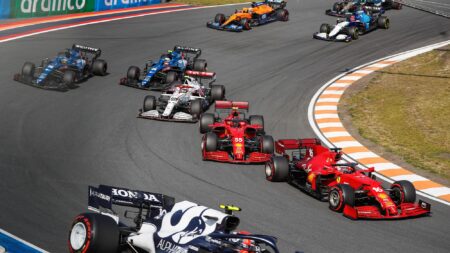“When they were asked about the track in Bahrain, for example, they all said to the press that it was fantastic. Well, I’ve talked to 20-30 per cent of them, and they all told me it was shit!”
Still, Bahrain, like other ‘Tilkes’, takes in the long-straight-followed-by-slow-corner sequence so vital in the design of any track if passing manoeuvres are to be attempted. This isn’t rocket science, as anyone who ever went to Zandvoort will tell you. If you watched at Tarzan, the wide, multi-line, 180-degree right at the end of the long pit straight there, you saw a whole season’s racing in one afternoon. The entry to Tarzan made you acutely aware of what men in cars can do.
Sadly, F1 deserted Zandvoort in 1985, but to this day I hold it was the best circuit for racing I ever saw.
Nor was it conceived by a computer. During the occupation of Holland Nazi gun emplacements in the sand dunes were linked by a series of service roads, and after the war these formed the basis of part of a new race circuit designed by John Hugenholtz, later responsible for Jarama and Suzuka.
In the hazy distance you’d see the cars exit Bos Uit, a long crocodile on the horizon, then begin to splinter, reds and yellows and blues fanning out and darting across the road, as Tarzan rushed up to meet them. At that stage it was a matter of staying off the brakes as long as you dared.
This was a stretch of racetrack to concentrate the mind. I remember Patrick Tambay talking about pit signals in 1982. “I found myself acting like a computer,” he explained. “You’re doing close to 200mph, but you know where your pit is — so you know that board is for you. You see it and store the info away. You can’t do anything more with it immediately because here’s Tarzan, and you can’t miss your braking point. Then, out of the corner, your pit signal comes back to you and you register what it all meant.”
For spectators, too, it was exhilarating — but scary. I invariably got through a lot of cigarettes during the course of a Dutch Grand Prix. Once in a while, as with Riccardo Patrese’s Arrows in 1979, you’d get a complete brake failure. In 1980 the front suspension of Derek Daly’s Tyrrell collapsed under braking, and two years later it happened to René Arnoux’s Renault. In every case the car went straight on, through the inadequate run-off area and head-on into the tyre wall. Always the impact was of shocking violence, and old notebooks reveal a sudden deterioration in my writing each time.
Somehow those three all walked away, but Zandvoort had some truly dark days. In 1970, my first time there, I remember clearly that pillar of black smoke twisting into a grey sky, scanning my lap chart and realising that Siffert and Courage were missing, and seeing Jo in the pits later, which meant it was Piers; remember, too, the joyless face of Jochen Rindt on the podium afterwards. And three years later it happened again, to Roger Williamson.
Any track with some bottle-age inevitably has a residue of tragedy among the lees, but more often than not Zandvoort was all pleasure, with a unique atmosphere, redolent of barrel-organ music, chips with mayonnaise and fresh, blustery, North Sea winds.
As well as providing a race of unusual sensation, it had also the knack of turning up an unexpected result. In 1959 the spoils were secured by Jo Bonnier in a BRM P25, the first GP victory for the team and the only one of the Swede’s long career. Wolfgang von Trips scored his first GP success there. So did Graham Hill and James Hunt. Jimmy Clark took the race in 1967 (his fourth GP win at the track), bestowing the revolutionary Lotus 49 with a fairy tale debut, and three years later the equally innovative 72 won for the first time, in the hands of Rindt.

